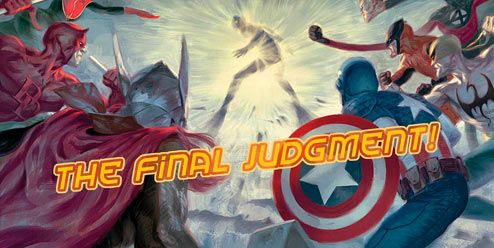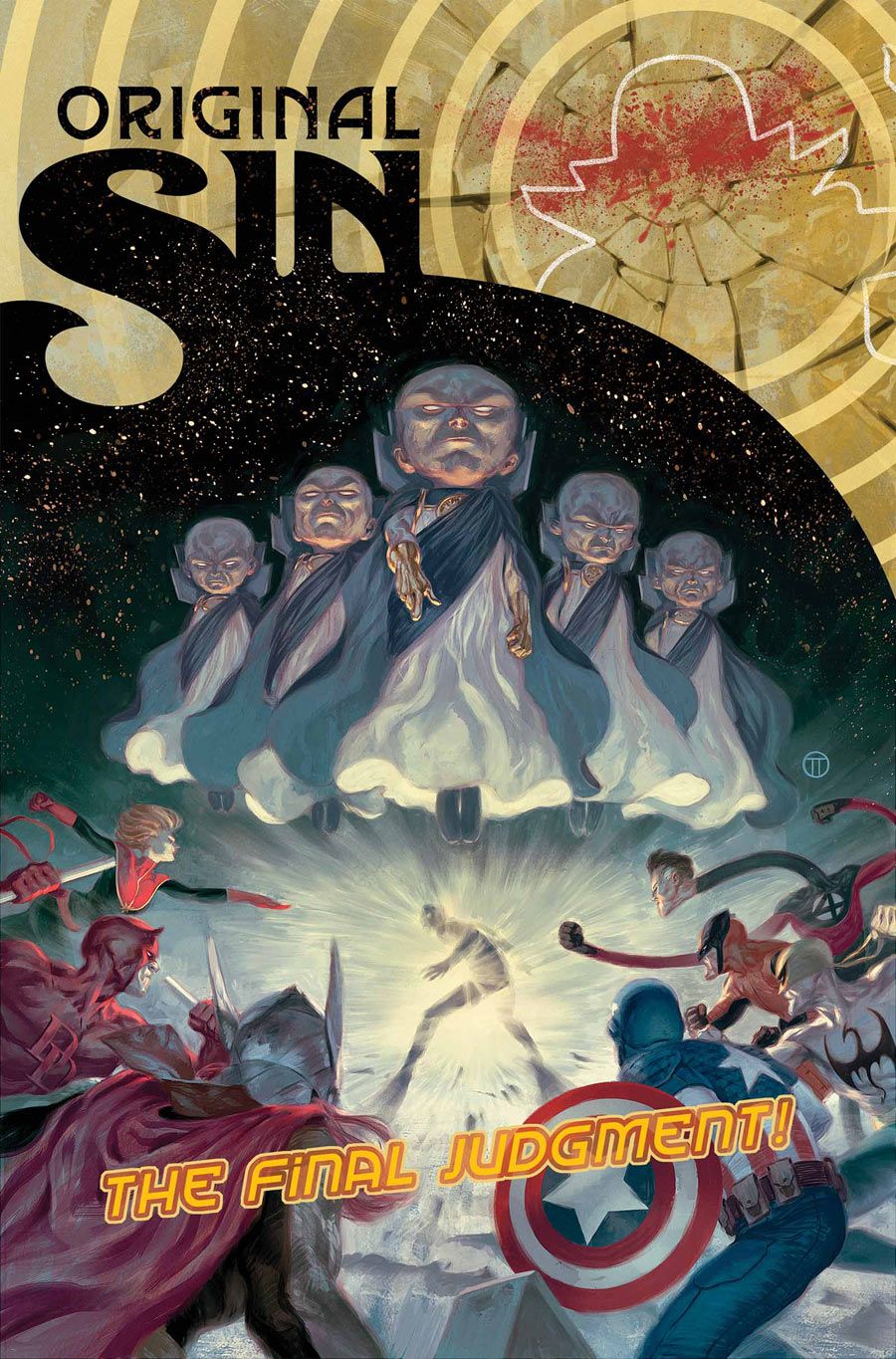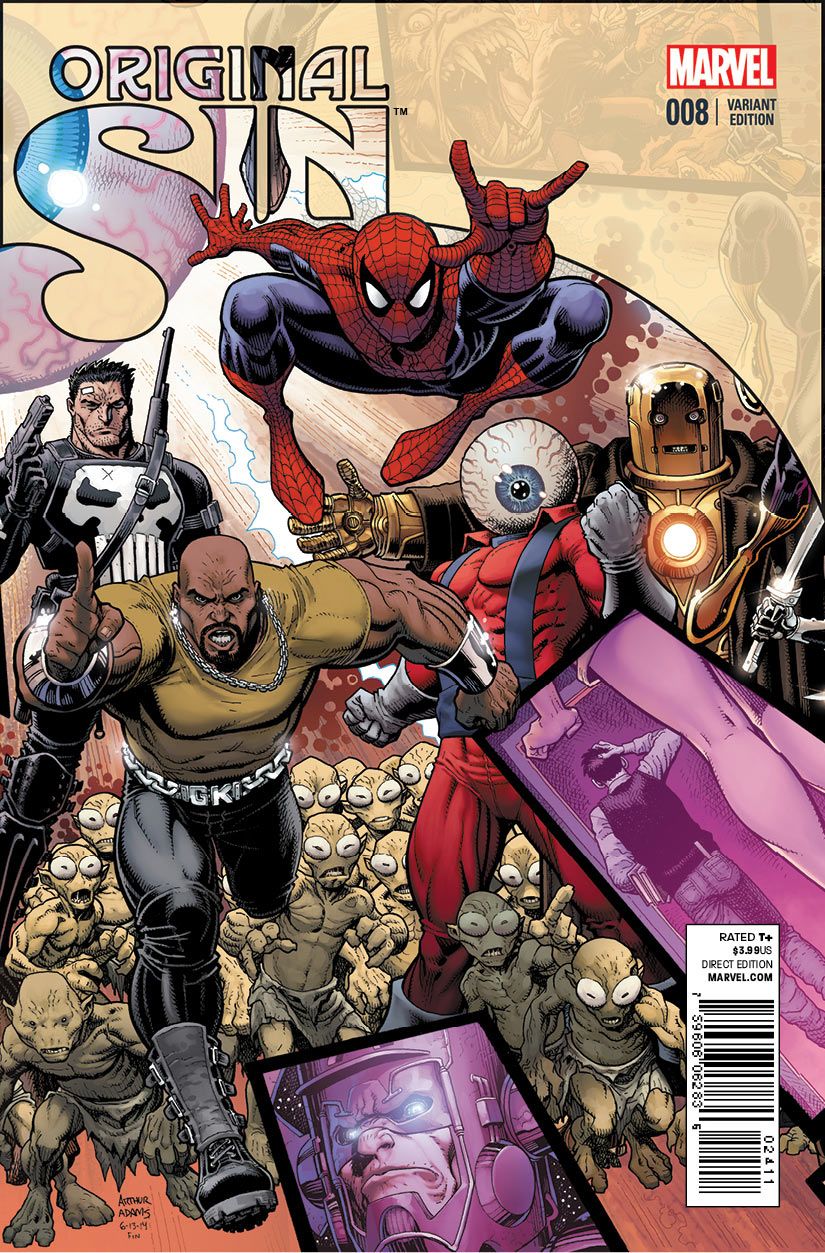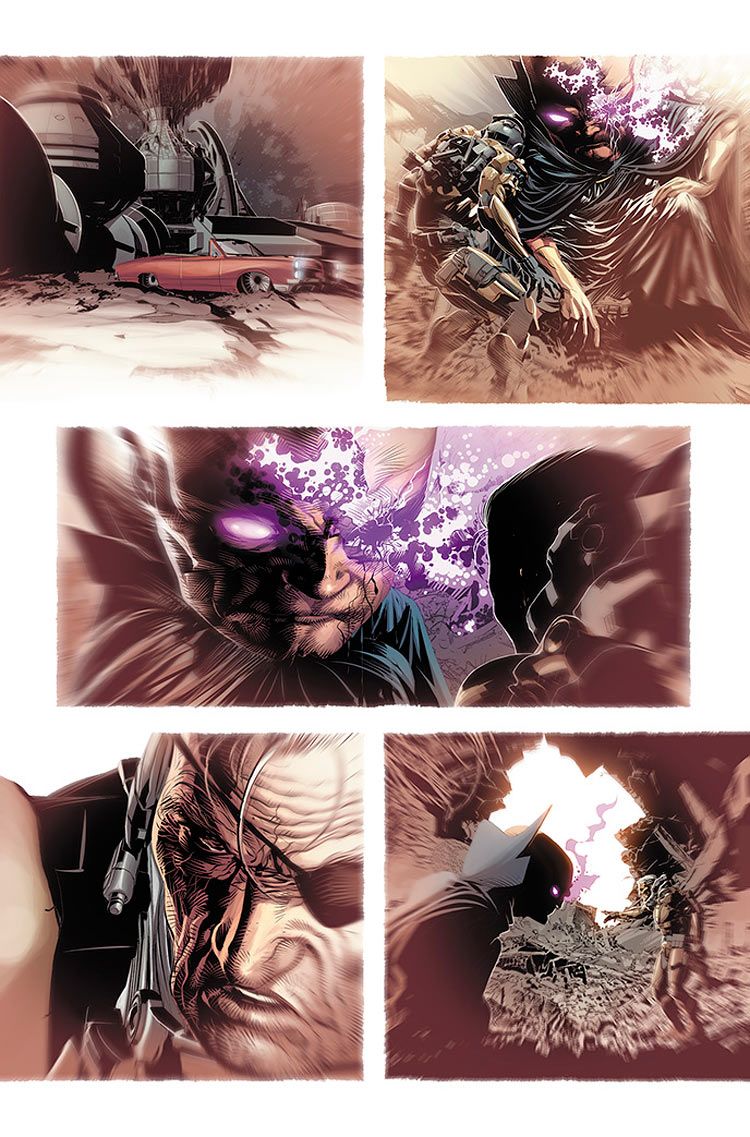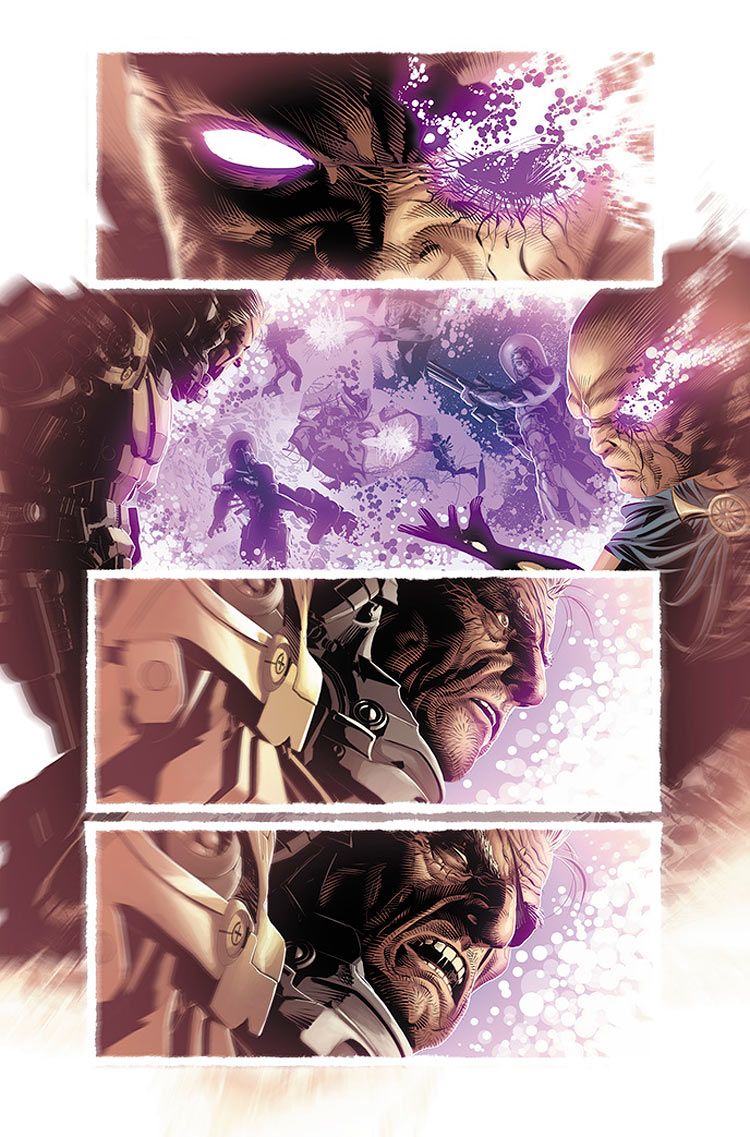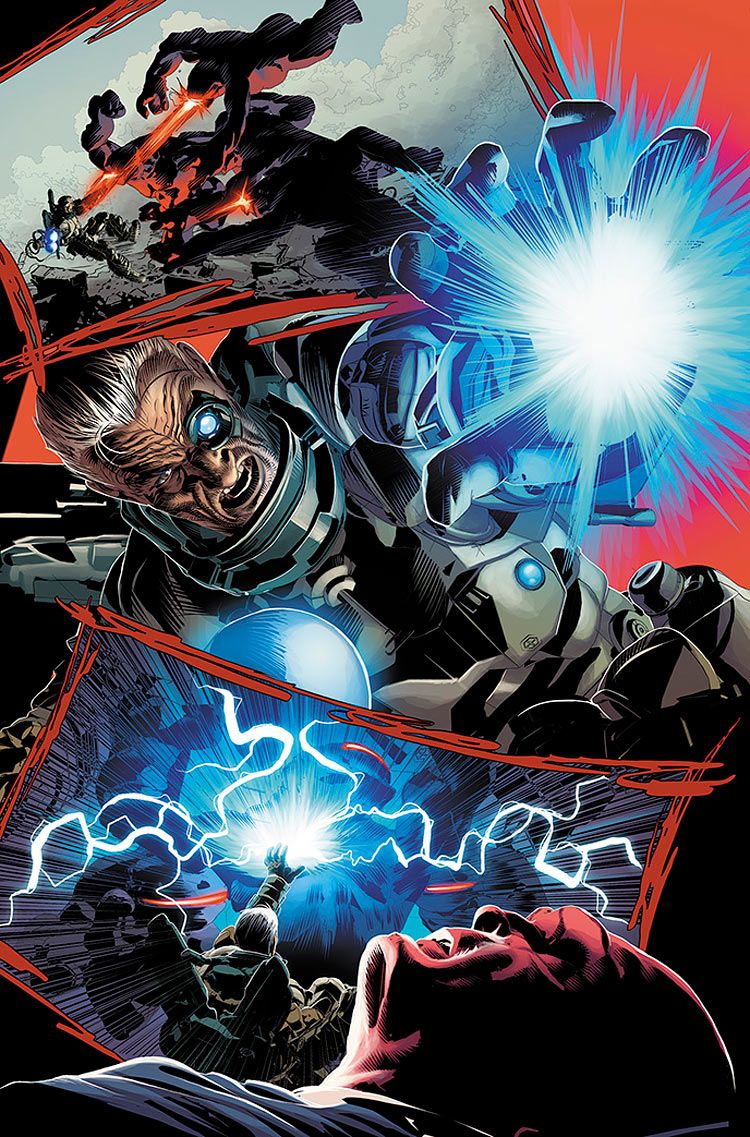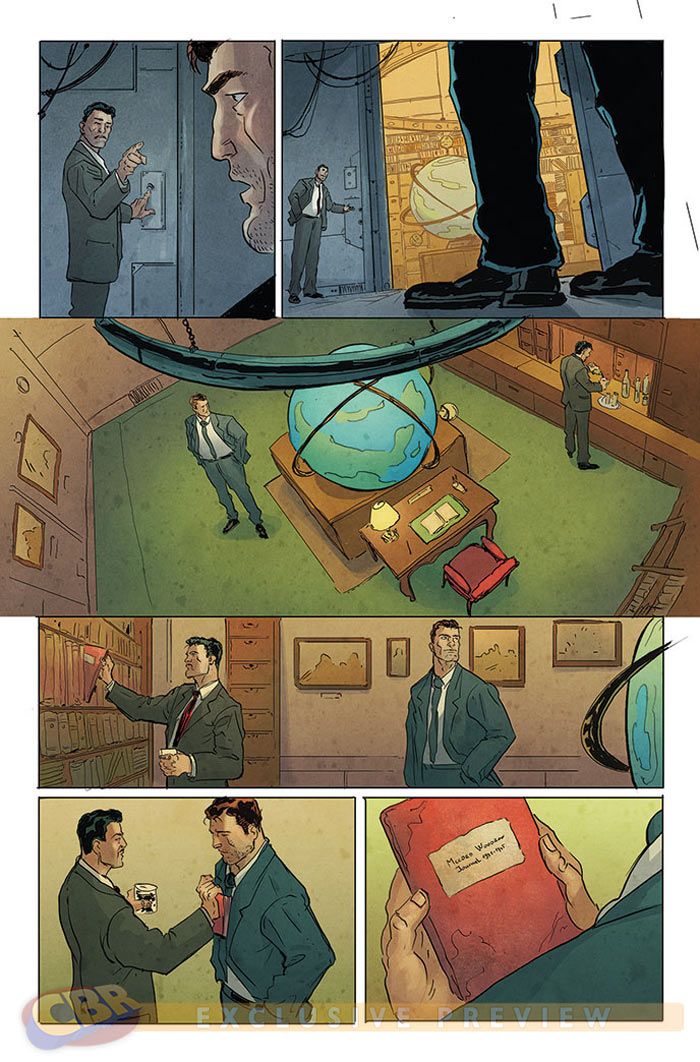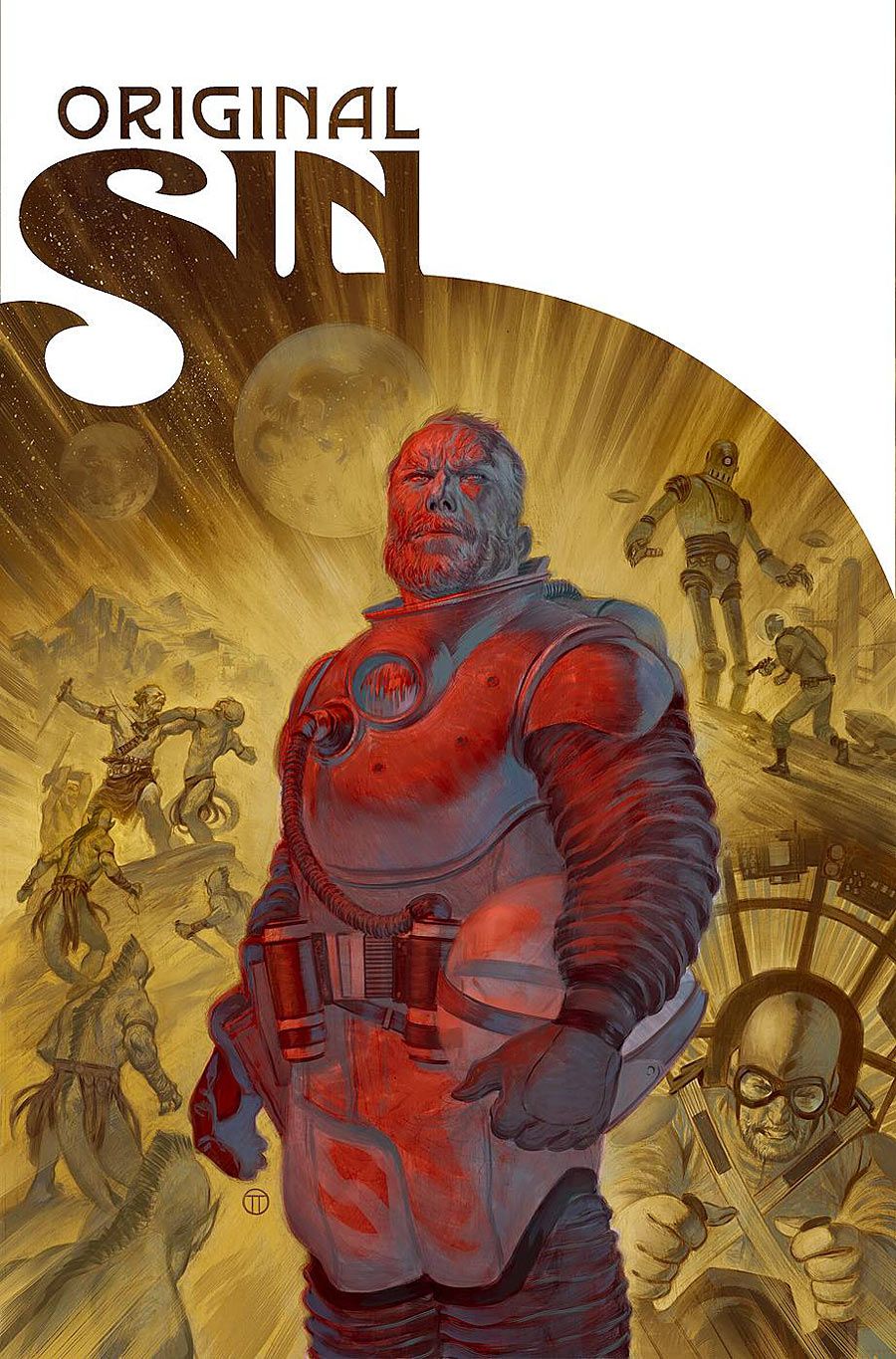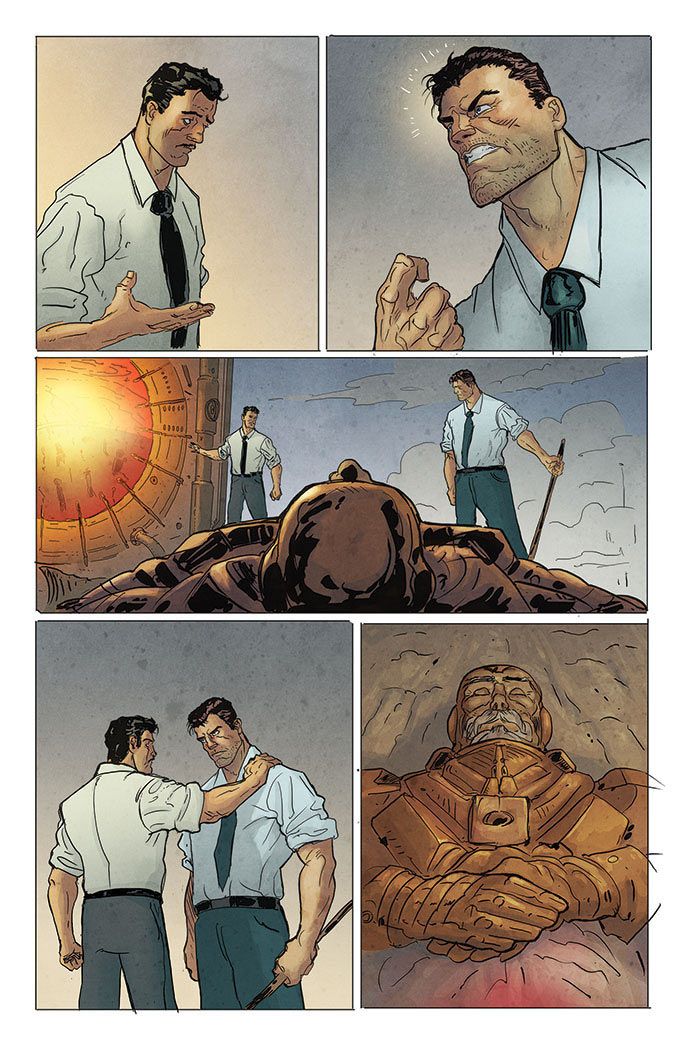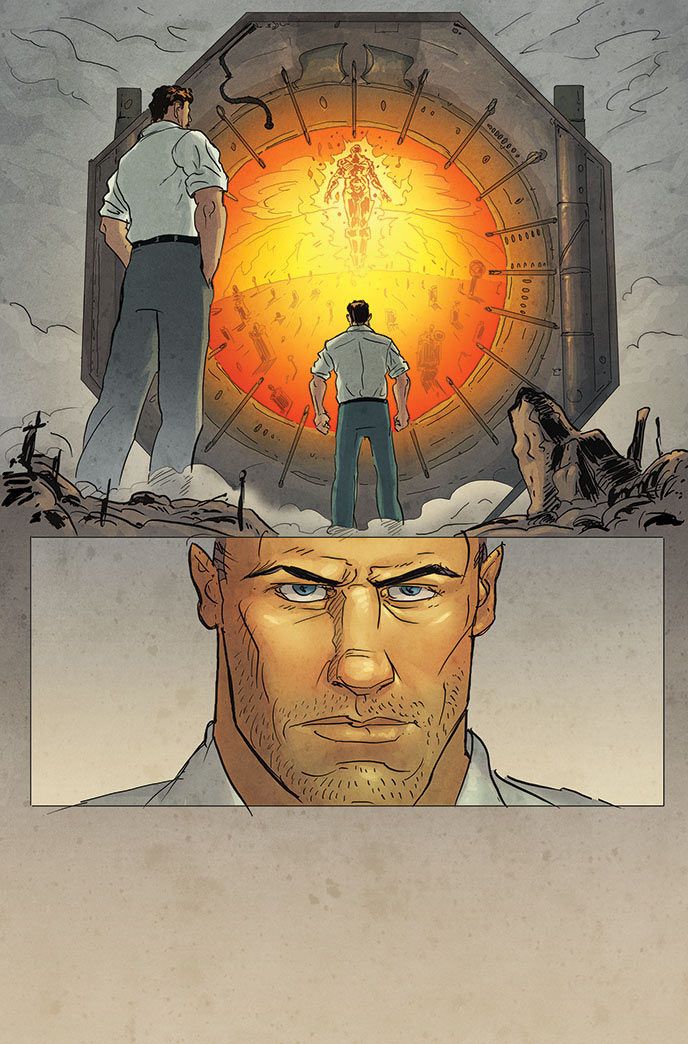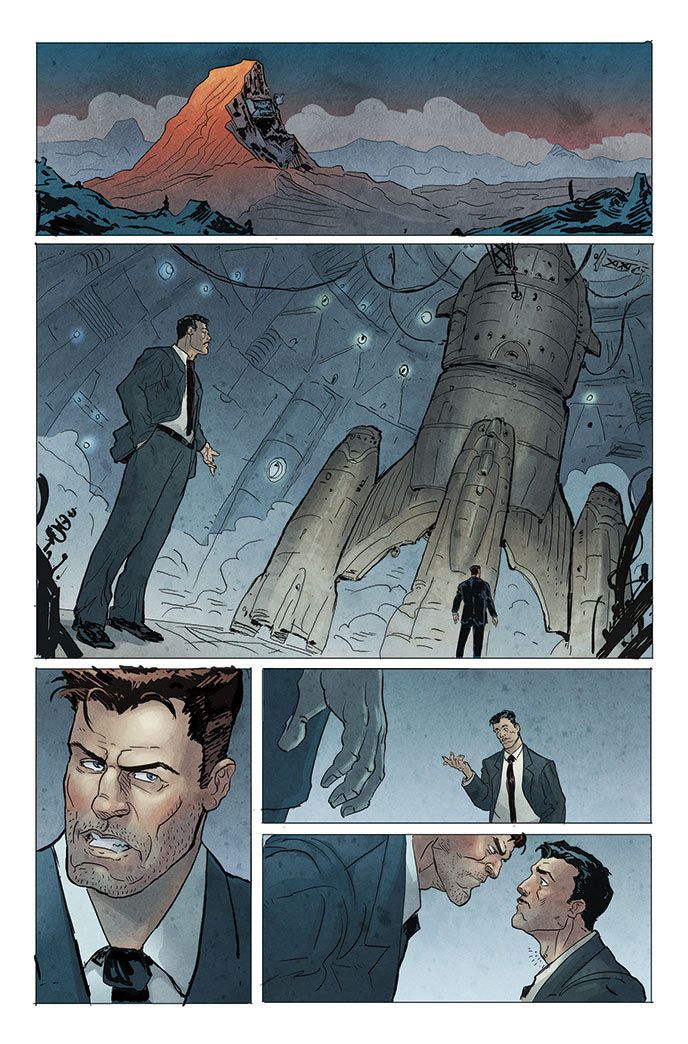Murder investigations have the unexpected side effect of digging up a community's long-buried secrets, especially if the victim was privy to all of these mysteries. That's precisely what happened in Marvel Comics event series "Original Sin" by writer Jason Aaron and artist Mike Deodato, as several different heroes set out to find out who killed the omniscient alien known the Watcher.
Their investigations brought a number of distressing secrets to light, including the secret alien hunting career of Nick Fury. In the series' final issue, "Original Sin" #8, the truth about Fury's involvement in the Watcher's murder was finally revealed in a climatic clash that featured the grizzled spy and the investigative team he brought together battle the villainous Midas family and their ally, the Orb. In today's final installment of MURDER MOST COSMIC, CBR's series of post-game chats about each issue of "Original Sin," we examine that conflict, the secrets that came to light and the transformative impact those events had on several characters. Aaron and Marvel Executive Editor and Senior Vice President of Publishing Tom Brevoort joined us for some insight into "Original Sin" #8 and what's next for the characters involved and the entirety of the Marvel U.
CBR News: Jason and Tom, let's start with the big reveal surrounding the murder mystery that launched this series. In the flashback segments of "Original Sin" #8 we see that Nick Fury was the one who ultimately ended the Watcher's life, but it looked like a scenario where the Watcher provoked Fury into using lethal force. Is that the case?
Tom Brevoort: I think you can make that case and I think certainly a defense attorney would make that case. As to how much truth there is to that? You see those events happen on the page and you can kind of draw your own conclusion based on what the Watcher says and does and what Nick says and does. As to what else might be in play or going through people's heads, one of the things that typically happens, especially in comics, is often we and our readers like things to be very neat and simple. In real life though, and most other fiction, it's not quite that neat and simple in most cases.
Human beings are complicated. They do things for a myriad of reasons and don't always act in a predictable fashion. So I always like situations where there's some ambiguity; where there are some aspects to what has gone on that the readers have to kind of fill in for themselves.
Inevitably the readers will show up, and probably for the next year, Jason and myself will be getting asked some version of this question. Some readers don't like that ambiguity. They want a definitive statement. I like that ambiguity though. So I'm perfectly happy to let things sit where they are. [Laughs]
MURDER MOST COSMIC: Jason Aaron Examines "Original Sin" #7
Jason Aaron: Yeah, I'm definitely a fan of ambiguity when it comes to something like this. You could say that, yeah, the Watcher provoked Nick, but that doesn't mean you can somehow give Nick a free pass and say that this was self-defense. It's a lot murkier and muddier than that, which is what I always wanted it to be. When you're dealing with a murder mystery things shouldn't feel tidy by the end of it.
It's neat and simple in that we know that who pulled the trigger. We know that it was Nick Fury. That's abundantly clear at this point, but as for how and why it happened? There are things that could be debated coming out of that.
Certainly Fury walks out of that situation on the one hand still feeling like it was worth it. This is what he had to do to fulfill his obligations and do his job. So he walks out of that situation telling himself he's the hero of the story. Whether you agree with him or not that's up to readers.
So the other question of "if the Watcher did indeed provoke Fury, why did he do it?" is something else that will remain hanging until someone comes up with a good story that tackles that question?
Brevoort: Yes, or possibly not even a good story! [Laughs] Sometimes we just come up with another story and tell it. Despite our best efforts we don't always hit the ball that well.
Aaron: [Laughs] I would say clearly that there's a lot going on here in terms of how we see characters changed by these events. Clearly the Orb has been changed in some way by this. He seems to be walking a different path than he was walking before. Very clearly Nick Fury was changed by this. He dies and appears to be reborn as something completely different carrying on in the footsteps of the Watcher.
There was a lot going on here underneath the surface beyond just Fury's quest and this murder mystery. As for what the Watcher's motivations are? You can speculate on that.
Since you brought up transformations, I wanted to touch upon them and their purpose to the story. "Original Sin" started by taking something out of the larger Marvel Universe toy box in the form of the Watcher, but ultimately it feels like the plan was to add back to the toy box in the form of these new concepts, new characters and new transformative roles for established characters.
Aaron: Yes, you don't want to just take. You want to give something back, and with any big event you want it to have some lasting impact on the characters involved and the Marvel Universe in general.
I feel good about this story in terms of telling a story with a clear beginning, middle and end. I think this story wraps up, but clearly the effects of it will carry on into other books.
Brevoort: I think we even talked about this before in the past, if not during these "Original Sin" conversations during some of our other conversations about past events. I'm always more in favor of net gain than I am of net loss. It's very easy to do a story where we kill of 10 characters and the sum total at the end is 10 guys are killed and one other guy is changed. That's your story.
Sometimes those are stories that are valid, but at the end of the day we're 10 characters down and the next story is consequently a little bit harder to come by, because it's the easiest thing in the world to kill off a character that people are invested in. It's much more difficult, though, to create a new character that people will become as invested in as the guy you just whacked. So as a general guideline I always like to approach almost any set of stories like this, but especially the bigger ones, with the idea of getting something more out of it at the end in total than what we started with.
That doesn't necessarily mean I have any objection to killing 10 characters. It's just that by the time we're done I would like to have 12 new characters, 12 new locales, 12 new gizmos or 12 new concepts that could become fodder for stories the next month because if there's one thing I know, there's always going to be a need for new stories.
Aaron: So does this mean you're rejecting my "The Orb Kills the Marvel Universe" pitch?
Brevoort: [Laughs] There might some revision required there.
Aaron: [Laughs] Darn it!
Brevoort: "The Orb Sees the Marvel Universe."
Aaron: "The Orb Wounds the Marvel Universe?"
Brevoort: [Laughs] The thing about the Orb now, and I was just thinking about this the other day is if he needed glasses he would have to wear the world's first pair of vertical glasses. I don't know what the hell that means, but there you go. That's my great insight into "Original Sin" #8.
Aaron: [Laughs] That sounds like a Chip Zdarsky story.
Brevoort: [Laughs] A little bit.
Let's talk about some of the characters that were transformed by the events of "Original Sin" #8, starting with Nick Fury. It appears that he's become a Watcher-like character who is now known as the Unseen. Can you comment at all on what Nick has become and what his new role is?
Brevoort: I think that we can say that he is the Unseen. I think we can say that very definitively. As to what he does other than stand around on the moon right now? We don't know. When we see him again in the future we'll find out exactly what his status is; exactly what he's going to be doing and how will become more apparent. I think you can draw some conclusions based on the events of "Original Sin" #8, but again I hesitate to say anything too definitively because I like to let the stories speak for themselves and I like the air of ambiguity and uncertainty; that sense of what's going to happen next? Where is this going? I hate to cut off possibilities by being too definitive.
MURDER MOST COSMIC: Aaron & Brevoort Deconstruct "Original Sin" #6
Aaron: One thing you can see in that ending is he appears to be literally chained to something. It could be the moon or the ruins of the Watcher's base, but he's chained to something. That all goes back to one of the debates that was at the heart of this story, which was Nick Fury versus the Watcher. Fury was a guy willing to do whatever it took to get the job done and keep the Earth safe. In his eyes the Watcher was this super powerful being who just stood around and watched. He never did enough. He never intervened or got his hands dirty enough.
That sort of back and forth was the heart of their relationship and how it evolved over the years. It was also clearly at the heart of the murder that happened. So that all kind of ends with this new role and transformation for Fury and the idea that being this person who watches is not the best gig in the world. It's torturous. It's kind of a curse. So in some sense you could look at this as sort of a passing on of that curse. It's like,"You think this is such an easy job? Here, you try it for awhile."
So Fury was the guy who was getting his hands bloody and would do whatever it took. Now he's literally the guy who is chained to the moon and just watching, which is kind of the ultimate punishment for a guy like him.
Who came up with the design for the Unseen?
Brevoort: The Unseen was designed by Carlos Pacheco obviously with a lot of input from Jason and myself.
I like it. It reminds me of a cool, twisted, almost cybernetic take on DC Comics' Destiny character.
Aaron: We're not familiar with DC Comics.
Brevoort: [Laughs]
Aaron: Sorry, go ahead, Tom.
Brevoort: No, I like your answer better. [Laughs]
[Laughs] Now that we've read all eight issues of "Original Sin," we know that more than any other character this was a Nick Fury story. I know this is a story that's been gestating for several years though. Were Nick Fury and his new role always going to be part of this story?
Brevoort: Not before Jason. We had inklings at earlier points when we talked about "Original Sin" that Fury would be involved and might be a principle player. I'm pretty sure that back during the brief period of time when it looked like Ed Brubaker might do a version of "Original Sin" that Fury was involved, but it didn't become this story until Jason took it at one of our retreats and said, "I'd like to take a crack at this." So this particular story that was created really is all Jason's.
Aaron: Yeah, I think when we initially started talking about it that there were maybe a couple different ideas for who the killer was.
Brevoort: There were actually quite a few because it felt like for a while there every three weeks Joe Quesada would come up with a new idea. [Laughs] It was a nice thing. He was really into the idea of this story particularly during the period when nobody was attached as a writer.
He would be on his coast-to-coast flights going back and forth to places like Marvel Studios and he'd be thinking about stuff. He'd then drop these long e-mails or documents.
I remember when Jason took this on one of the first things I did was I sent him kind of the "File of Correspondence." It was like, "Here's all the stuff that Joe wrote up on this. Feel free to take anything from it you want and feel free to discard anything that you don't think works. None of this is set in stone. This is all him spitballing different ideas and elements that excited him." Within that I'm sure there are probably half a dozen different versions of who could have done this, and in fact probably a couple different murder victims.
Nick Fury wasn't the only character transformed by the Watcher's eye. The Orb underwent some radical changes as well. What can you tell us about what he's become and his new role? The last few pages suggest he's almost become a voyeur when it comes to suffering and misery.
MURDER MOST COSMIC: Aaron, Brevoort Reveal the Secrets of "Original Sin" #5
Aaron: What you just said sounds like a pretty cool idea for a story. I'd read that!
Brevoort: [Laughs] If nothing else he still has one of the Watcher's eyes. So presumably there's at least a potential that he in some way shape or form can commune with all of the information that's held inside it, which is now held inside him.
Aaron: Right, he's got that Watcher eyeball pretty much growing out of his chest. The other one was right there with Fury when everything blew up. So the Watcher's eyes were kind of divvied up.
What role the Orb plays and where he goes from here will sort of just depend on where we'll see him next. Clearly I've been a big fan of the Orb because I've written him in so many different comics, but he popped up in this initially because it was Tom's idea.
Brevoort: It was.
Aaron: Even though I told him that nobody would believe that.
Brevoort: [Laughs] They still don't.
Aaron: I've written him as a joke at times in "Ghost Rider" and a lot of other places like "Hulk," but I like the idea of getting him to an ending point here that was a little bit creepy. So I had that idea pretty early on of him popping up at somebody's door and somehow knowing that this horrible act was about to take place. He doesn't want to stop it he just wants to watch.
So I don't know. We'll see where he goes from here. I've certainly got a couple years left on my Marvel exclusive. So chances are good that somewhere in there you'll see me write the Orb again. I'm sure I'll be fighting to do that.
Brevoort: It definitely seems like he's a more demented version of the Watcher at this point; showing up at those awful moments not only to watch, but to sort of soak up the ambience, so to speak.
Aaron: Right, he shows up at this doorstep because he somehow knew this murder was about to take place. Clearly, he sees things just like the Watcher would see things. That seems to be a pretty big power, a pretty big change for him, and a pretty big step up. As to what he can do with that? Who knows? Will he just wander around and watch terrible things happen? Or will he do more with it? That remains to be seen.
Physical metamorphoses weren't the only transformations that occurred in "Original Sin" #8. We also saw a number of characters whose roles were transformed. Let's talk about them, starting with the Winter Soldier who decided to become the new "man on the wall." I imagine Bucky's reasons for taking up this role and whether or not his methods will be different than his predecessor's are things Ales Kot and Marco Rudy will explore in their upcoming "Bucky Barnes: The Winter Soldier" series. What can you tell us about your editorial reasons for giving Bucky this role? And what can you tell us about the history of this role? Is this something that was always going to be part of "Original Sin?"
Brevoort: This was something that Jason came up with as a part of "Original Sin." In building Nick's backstory and the structure for what was going on with Nick, his relationship with the Watcher, and all these secret things he had been doing over the years. All of that was Jason's invention.
At a certain point it was just a good sort of confluence of elements. Of the characters we assembled, and we assembled them for very specific reasons connected to the investigation and connected to who and what those characters were, but Bucky in particular has a lot of parallels to Nick.
For all that Nick told him, "I never liked you," they kind of come from the same stock. They grew up in the same era, although Nick was a couple of years older. They were both kids of, if not poverty stricken, certainly financially challenged homes during the Depression. They both fought in World War II. They both suffered injuries. In the case of Bucky he lost an arm and years of his life as opposed to Nick losing an eye. They're both pretty hard boiled characters in their own way.
So the notion of what Fury has said and done would resonate with Bucky seemed to make sense. Plus it put that character on a completely different playing field and stage than we've seen him before. That seemed to be interesting and it was an opportunity to move him out of the shadow of still being Captain America's sidekick and into something that could be completely his own and that he could own wholeheartedly. So it seemed like a good opportunity and we decided to capitalize on it.
Another character coming out of "Original Sin" with a new role to play is The Exterminatrix, Oubliette Midas. He final scenes in issue #8 suggested she's no longer content to play the role of enforcer in someone else's criminal empire and wants to take the throne of her seemingly dead father. Is that correct?
Aaron: Yeah, it appears she's going to take over or continue on the Midas empire. So I like the idea of taking her up a notch to be a bigger and more colorful threat in the Marvel Universe.
What can you tell us about where we might see Oubliette next? Jason, I know like the Orb she's a character you have some affection for. Are you dying to get a crack at her?
Aaron: Yeah, I have some ideas and we'll see where they go.
Let's move away from the characters and into the Herculean effort of the art team that brought them to life in every single issue of "Original Sin" -- artist Mike Deodato and colorist Frank Martin.
Aaron: I think this was a gorgeous book from beginning to end. It was an amazing feat that we were able to have the same art team on every issue of a big event book that came out twice a month and had a million characters.
As you said, that was a Herculean effort, but it wasn't like they were hacking it out. I think the book got more interesting, daring, and visually inventive as it went along and got more complicated and filled with more and more characters. So I think it was a tremendous feat from our art team. Mike also had a baby in the middle of it too.
Brevoort: And it should be noted that he did this issue, a 30-page issue, in under 30 days. So a page day every day at minimum, and there were a couple days he doubled up and was able to put two pages in the box.
He was determined to hit all of our dates and have everything come out at the time it should. He wanted to have it all be by him, and by the end he was like a force of nature. Nothing could stop him.
Looking back at the series as a whole, what are some of the scenes that Mike and Frank did that you especially enjoyed and stuck with you?
Brevoort: I like most of the scenes, but I actually really like the quieter stuff. I like most of the stuff that was in issue #1 like the sit down at the diner. That's a conversation scene, which isn't always easy to make look dynamic or dramatic, but Deo was able to do that and then follow it up with a double-page spread and a large panel across the top of an old 1960s car flying to the moon. I liked all of that sort of stuff.
It was less about a scene and more about the style in which he delivered stuff. When we began working on this and he got the first scripts we talked about it being sort of a noir piece and because it's a Fury story having a certain Steranko vibe to it. It feels like he really engaged that gear without just doing a Steranko pastiche and aping the moves that Jim made 40 years ago. Deo gave you something that visually, in terms of the way the pages are broken down, how the panels sit, and the flow of the story is very different than any other Mike Deodato story that you may look at.
If you look at what he's done before this and compare it he's not doing the same thing. I think he brought a lot of mood and nice atmosphere to what went on and at the same time was able to do all the punching and pyrotechnics.
Aaron: There were two scenes that I especially enjoyed. One was the scene in issue #2 where Fury fights the Mindless One in his car, which was great. It's the first Nick Fury action scene that we see. Then the opening of issue #3, which are a couple of real simple pages. It's just the Orb talking. We got the reveal of him at the end of issue #2 and then we flashback with a whole page of him talking and the reveal of Doctor Midas and his daughter. Those could have been very static pages, but Mike did these wild layouts breaking everything up into boxes and makes what could have been a boring few pages really dynamic.
That wasn't even supposed to be a double-page splash. I think he just drew it like that. So an action scene and a scene of people sitting around talking are my two favorites.
Brevoort: It occurred to me as I was listening to you talk that the other page I liked an awful lot was the last page of issue #4, the moment where old Nick comes out at the end of the issue. Not only was that a nice dramatic shot, he gave it that slight upshot, but you could instantly tell that it was Nick and you could instantly tell that it was a much older Nick than any Nick we've seen. He communicated a lot about who that character was just in that single image, pose, and shot with the attitude and the composition of it. I thought it was very nicely done.
From what we've seen and what you're saying, Mike sounds like a guy who's an expert on action scenes, but he's also very aware of scenes that could just be talking heads and goes out of his way to make those scenes visually dynamic and special.
Brevoort: I think so. For all that Deo worked on this very quickly it's not like he didn't work on it diligently or hard. There weren't any pages where he was just phoning it in and doing the same six panels of the same go to poses that he always has. I think he was thinking about the story and the storytelling of it and conveying the mood, the sense of scene, and the emotional tenor of what's going on. In sequences that in other hands might have been dull he was looking for that extra thing to make them sparkle and to bring home the feeling and the flavor that those scenes were meant to have.
Now that we've reached the end of "Original Sin" and these interviews, I have a question for each of you about reaching the end. Jason, how does it feel to have your first solo Marvel Universe event series complete and in the hands of readers. And Tom, how does it feel to come to the end of a different kind of Marvel event where every issue came out on time and there were no spoilers beforehand about the mystery?
Brevoort: [Laughs] What are you saying, sir? What do you mean to imply by that?
Aaron: [Laughs]
I'm saying that sometimes a certain four-letter word happens and you have to deal with it.
Brevoort: [Laughs] There is truth in what you say.
Aaron: [Laughs] Well it feels great for me. I had done this sort of thing before, but never on my own. So I survived. Tom and I are still speaking and I'm not banned from the halls of Marvel. So that's all good. I made it through alive and it was fun.
It's a different experience doing a big event book like this, but I had a good time. I felt like I got to do a story that felt like mine. I think if you look at all the stuff I've done for Marvel and thought, "What would it be like if this guy wrote a Marvel event?" I think it would be like this. It would have characters like the Orb. It would have big, crazy ideas. It would have an Ego the Living Planet-style character who had been murdered by a gun. It would also be dark and gritty at times and have the Punisher running around.
That's what I was able to do, and the response that I've seen has been really, really great. So people seem to have dug it and I accomplished what I wanted to accomplish.
Brevoort: For me this was over three or four weeks ago when I sent the issue to press. So I'm in the middle of "Avengers & X-Men: AXIS" now. [Laughs] I haven't had time to think, "It's done! Hooray! I can have the parade." No, there's something else that has to be dealt with immediately.
I feel like "Original Sin" turned out well. I think that it was great that Jason, Deo, Frank and everybody was able to do the core story start to finish. I'm very happy about that. I think it played pretty well. The response was very nice and we'll see more today [Editor's note: This interview was conducted the same day "Original Sin" #8 was released.] with people coming out of the woodwork to tell us their opinion of the story overall now that they've seen the whole shape and scope of it.
That is one of the things that Brian [Bendis] talks about a lot. He had a lot of experience with this because he and I did a bunch of these big event series together. One of the things that he finds as he gets feedback over the years from people is that people who come to the story as a complete story tend to like it more because that uncertainty principle is gone.
While you're reading the story and you're halfway in, anything can happen. So readers are worrying about the worst things happening to the characters they love. Whereas, once it's a book on a shelf that's all collected and complete you kind of know going in, even if you haven't read the story, what the impact of the story was. You don't have to have that trepidation. So while the same scenes and sequences play out they take on a different tenor, and people tend to appreciate the work that's there more sometimes than they do while it's going on.
It's kind of the difference between being in the middle of a roller coaster ride and walking off after the end of the roller coaster ride. So now for "Original Sin" people will be able to read it front to back and evaluate it as a whole experience. They'll have a sense of it going in and not be worried that, "Oh my god! They're going to kill Nick off!" Hopefully people will continue to enjoy it and like it for a long time to come.
"Original Sin" #8 is on sale now.

